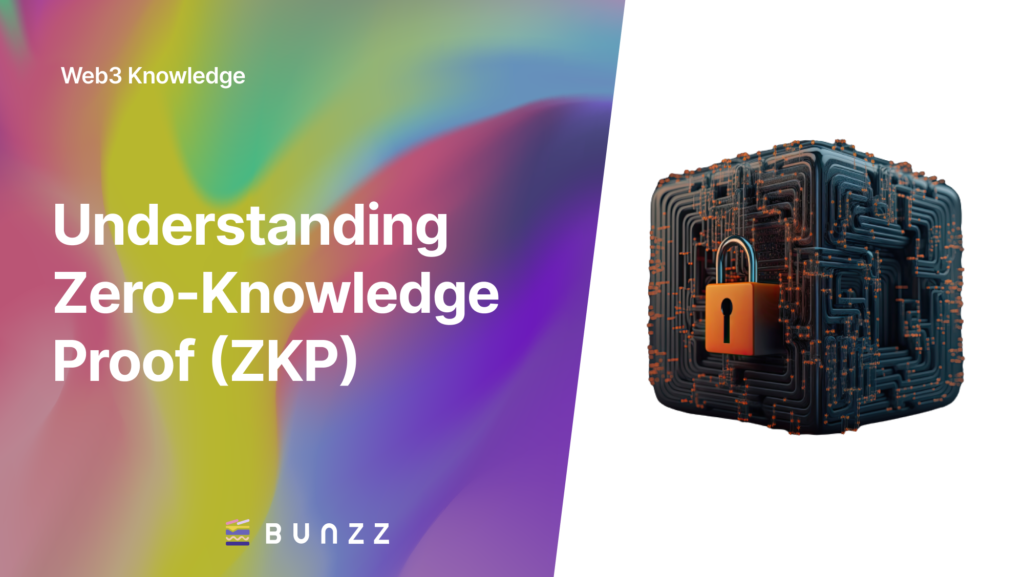What is ZKP
In cryptography, zero-knowledge proofs allow one person to prove to another person that they know something or have done something, without revealing what that information or action actually is. So, Person 1 can convince Person 2 that they have knowledge of something, without actually revealing the details of that knowledge to Person 2.
Imagine you are a detective investigating a case, but you don’t want to reveal your sources to the suspect or anyone else. However, you must prove to the suspect that you have evidence to support your claims. This is where a zero-knowledge proof comes in.
You can think of zero-knowledge proof as a way to convince the suspect that you have evidence to support your claims without revealing your sources or the actual evidence. It’s like showing the suspect a blurred-out image of the evidence, or a summary of the key points, without showing them the full picture.
In this analogy, the suspect represents the verifier, and the detective represents the prover. The evidence represents the statement being proven, and the sources represent the witness. The zero-knowledge proof is like a summary of the evidence that convinces the suspect of the truthfulness of the claims without revealing the evidence or sources.
This analogy highlights the key idea behind zero-knowledge proofs – that they enable a prover to prove the truthfulness of a statement to a verifier without revealing any additional information beyond the truthfulness of the statement itself.
Types of ZKP
Zero-knowledge proofs can be classified into two main categories: interactive and non-interactive.
- Interactive zero-knowledge proofs involve back-and-forth communication between the prover and the verifier. The prover sends messages to the verifier, and the verifier responds with a challenge. The prover then uses the challenge to generate a new message, and the process continues until the verifier is convinced of the prover’s claim. Interactive zero-knowledge proofs can be more secure than non-interactive proofs because the verifier can ask for additional information if they are unconvinced. Still, they are also slower and more resource-intensive due to the need for multiple rounds of communication.
- Non-interactive zero-knowledge proofs, also known as zk-SNARKs (Zero-Knowledge Succinct Non-Interactive Argument of Knowledge), do not require any back-and-forth communication between the prover and verifier. Instead, the prover creates proof that can be verified by the verifier using a pre-computed verification key. Non-interactive zero-knowledge proofs are faster and more efficient than interactive proofs, but they can be less secure because the verifier needs the opportunity to ask for additional information.
Non-interactive zero-knowledge proofs are more commonly used in blockchain applications because of their efficiency and scalability. However, interactive zero-knowledge proofs can be used in applications where security is a top priority, and the cost of additional communication rounds is not a concern.
Applications of ZKP
Zero-knowledge proofs have a wide range of applications in blockchain DApp (decentralized application) development, as they can help to enhance privacy, security, and efficiency in various blockchain use cases. Here are a few examples:
- Authentication: Zero-knowledge proofs can be used in blockchain DApps to provide secure authentication and access control. Instead of traditional password-based authentication, a zero-knowledge proof can be used to prove that the user can access certain information, such as a private key, without revealing the key itself.
- Transactions: Zero-knowledge proofs can be used to verify the validity of transactions on a blockchain without revealing sensitive information about the transaction, such as the sender, receiver, or transaction amount. This can enhance privacy and security for blockchain users.
- Identity verification: Zero-knowledge proofs can be used in blockchain DApps to verify the identity of users without revealing any personal information. This can be particularly useful in healthcare, finance, and government industries, where privacy and security are critical.
- Supply chain management: Zero-knowledge proofs can be used to ensure the authenticity of products and goods in a supply chain. For example, a zero-knowledge proof can prove that a specific company manufactured a product without revealing any proprietary information about the manufacturing process.
Overall, zero-knowledge proofs can enhance the privacy, security, and efficiency of blockchain DApps by providing a secure way to exchange information without revealing sensitive details.
Properties of ZKP
Zero-knowledge proofs (ZKPs) have several properties that make them a valuable tool for enhancing privacy and security in various applications. Here are some of the key properties of ZKPs:
- Completeness: A ZKP protocol is said to be complete if an honest prover can convince an honest verifier of the truthfulness of the statement being proven.
- Soundness: A ZKP protocol is said to be sound if a dishonest prover cannot convince an honest verifier of the truthfulness of a false statement with high probability.
- Zero-knowledge: A ZKP protocol is said to be zero-knowledge if the verifier learns nothing about the witness or input other than the truthfulness of the statement being proven.
Types of ZKP Protocols
There are several types of zero-knowledge proof protocols, each with its own unique features and use cases. Here are some of the most common types of zero-knowledge proof protocols:
- zk-SNARKs: zk-SNARKs (Zero-Knowledge Succinct Non-Interactive Argument of Knowledge) is a type of zero-knowledge proof protocol that allows one party (the prover) to prove to another party (the verifier) that they know a solution to a problem without revealing the solution itself. zk-SNARKs are widely used in blockchain applications for privacy-preserving transactions.
- zk-STARKs: zk-STARKs (Zero-Knowledge Scalable Transparent Argument of Knowledge) is a type of zero-knowledge proof protocol that allows one party to prove knowledge of a solution to a problem without revealing the solution. zk-STARKs are designed to be more transparent and scalable than zk-SNARKs, making them suitable for public blockchains.
- Bulletproofs: Bulletproofs is a type of zero-knowledge proof protocol that allows for the efficient verification of range proofs, which are used to prove that a value is within a certain range without revealing the actual value. In cryptocurrency transactions, bulletproofs enable more efficient and private proof verification.
- SONIC: SONIC (Scalable, Non-Interactive, and Covertly Verifiable Zero Knowledge) is a type of zero-knowledge proof protocol that enables efficient zero-knowledge proofs without the need for an interactive setup process. SONIC is designed to be more efficient and scalable than other zero-knowledge-proof protocols, making it suitable for various applications.
- PLONK: PLONK (Permutation-based, Linear, and Non-interactive Zero-Knowledge) is a type of zero-knowledge proof protocol based on permutation arguments. PLONK is designed to be efficient and scalable, making it suitable for use in blockchain applications such as cryptocurrency transactions.
These are just a few examples of the many zero-knowledge-proof protocols available. Each protocol has its strengths and weaknesses, and the choice of the protocol will depend on the specific requirements of the application being developed.
Advantages and Disadvantages of ZKP
Zero-knowledge proofs (ZKPs) have several advantages and disadvantages that developers should be aware of. Here are some of the key advantages and disadvantages of ZKPs:
Advantages:
- Enhanced privacy: ZKPs provide a way to prove the truthfulness of a statement without revealing any additional information beyond the truthfulness of the statement itself. This makes ZKPs a valuable tool for enhancing privacy and protecting sensitive data.
- Improved security: ZKPs can be used to enhance the security of various applications, such as digital currencies, by enabling secure and private transactions without the need for trusted intermediaries.
- Scalability: ZKPs are typically more scalable than other privacy-enhancing technologies, such as encryption, because they do not require additional storage or computation resources.
- Flexibility: ZKPs are a flexible tool that can be applied to various applications and use cases, from authentication to data sharing to secure computation.
Disadvantages:
- Complexity: Implementing ZKPs can be a complex and challenging task requiring cryptography and mathematics expertise. This can make it difficult for developers to integrate ZKPs into their applications.
- Performance overhead: ZKPs can introduce additional computational overhead, which can impact the application’s performance. However, this overhead can be reduced through careful optimization and the use of efficient ZKP protocols.
- Trust assumptions: ZKPs rely on certain trust assumptions, such as the security of the underlying cryptographic primitives and the integrity of the hardware and software used to generate and verify the proofs. Any vulnerabilities or weaknesses in these trust assumptions can compromise the security and privacy of the ZKP.
- Limited adoption: ZKPs are still a relatively new and emerging technology, and their adoption is currently limited to a few niche applications. However, this is likely to change as the technology matures and more use cases are identified.
How can developers implement ZKP?
Implementing zero-knowledge proof (ZKP) protocols can be a complex task requiring cryptography, mathematics, and programming expertise. Implementing zero-knowledge proofs in a DApp involves using a specialized cryptographic protocol to enable secure exchanges of information between parties. However, here are some general steps that a developer can follow to implement a ZKP protocol:
- Choose a ZKP protocol: The first step is to choose a ZKP protocol suitable for the specific application. Several ZKP protocols are available, each with its own strengths and weaknesses, so the choice will depend on the application’s specific requirements.
- Design the proof system: The next step is to design the proof system that will be used to generate and verify proofs. This involves defining the problem to be solved, identifying the input and output variables, and determining the constraints that must be satisfied.
- Implement the proof generation algorithm: Once the proof system is designed, the developer needs to implement the algorithm that generates the proof. This involves various mathematical computations, such as creating a witness for the input variables, generating a commitment, and constructing the proof.
- Implement the proof verification algorithm: The next step is implementing the algorithm that verifies the proof. This involves checking the proof against the constraints specified in the proof system, verifying the commitment, and checking the validity of the witness.
- Integrate the ZKP protocol into the application: Finally, the ZKP protocol must be integrated into the application. This involves writing code that calls the proof generation and verification algorithms at the appropriate points in the application’s workflow.
It is worth noting that implementing ZKP protocols can be a challenging task that requires careful attention to detail and a strong understanding of the underlying mathematics and cryptography. Developers may consult with experts in these fields or leverage existing libraries and tools to simplify implementation.
——–
The Bunzz platform provides many options for blockchain developers looking to build DApps with 100+ ready-made smart contracts. Start building today!







